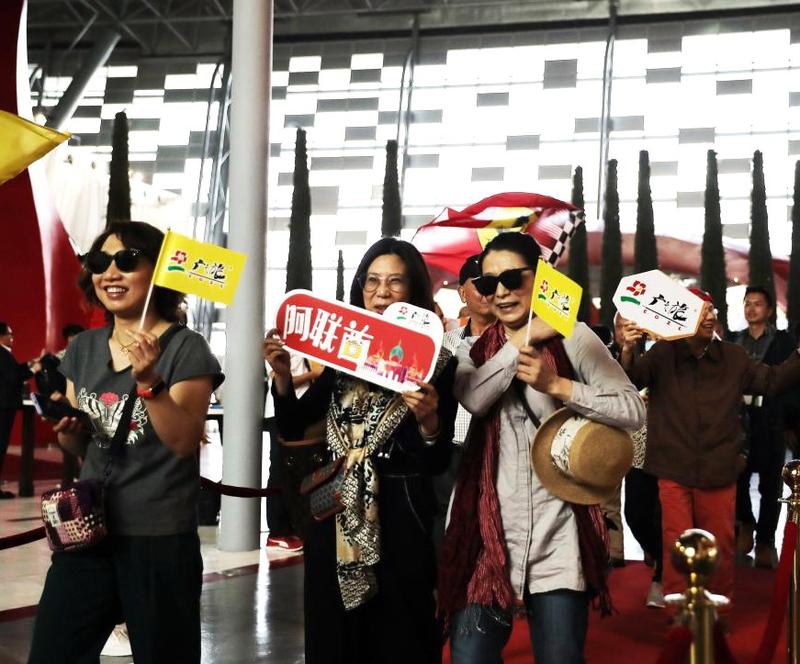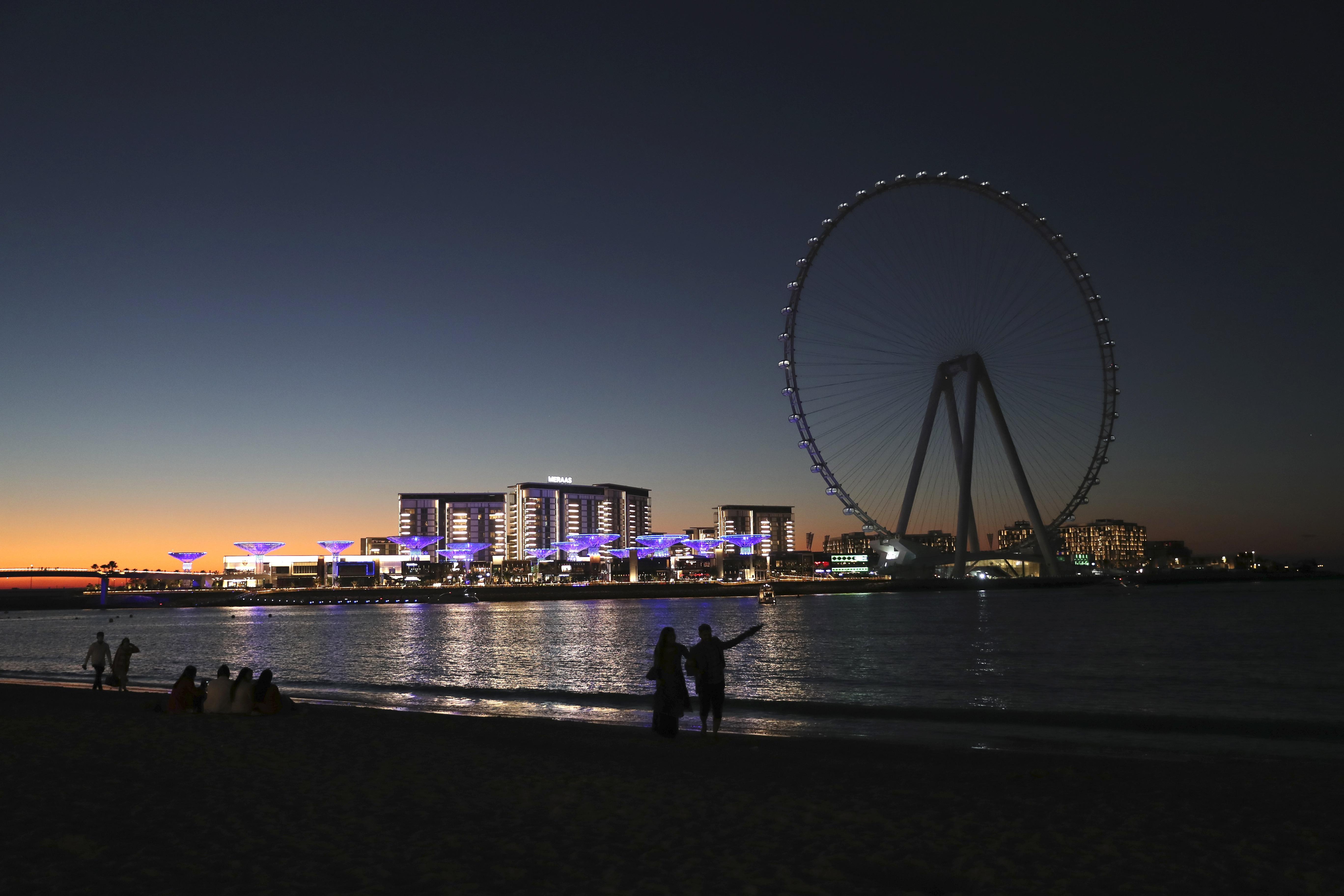Gulf nation hails China-proposed infrastructure program for contributing to economic diversification
 Chinese tourists arrive at the theme park Ferrari World Abu Dhabi in Abu Dhabi, the United Arab Emirates, on Feb 7. (PHOTO / XINHUA)
Chinese tourists arrive at the theme park Ferrari World Abu Dhabi in Abu Dhabi, the United Arab Emirates, on Feb 7. (PHOTO / XINHUA)
Editor's note: This year marks the 10th anniversary of the launch of the Belt and Road Initiative. A decade of practice has demonstrated that it's a broad and prosperous way for China and the world to share opportunities and seek common development. In a more than 10-part series, China Daily finds out how the road of peace, prosperity, openness, green development, innovation and civilization will contribute more to the shared future of mankind.
A decade after Chinese President Xi Jinping proposed the Belt and Road Initiative to the world, beneficiaries and partners in the United Arab Emirates are hailing the global infrastructure development program for boosting the Arab nation's economic diversification plans.
Fatima Al Hammadi, chief commercial officer of Economic Cities & Free Zones, AD Ports Group, said the UAE-China cooperation in the BRI can result in increased capacity for manufacturing, trade and connectivity for the UAE, further enhancing its position as a global supply chain hub.
In recent years, the UAE has introduced a raft of initiatives that would strengthen its position as a global partner and its status as an attractive and influential economic hub. Among them is "We the UAE 2031", a national plan that will guide the UAE's development path in the next decade, focusing on social, economic, investment and development aspects.
Some of the key indicators of the vision include doubling the country's GDP to 3 trillion dirhams ($816 billion) from 1.49 trillion dirhams, and generating $217 billion in non-oil exports and raising the value of the UAE's foreign trade to $1.8 trillion.
The plan ties in with the "UAE Centennial 2071" vision launched by the UAE Cabinet in 2017 to advance the country's education, economy, government development, and community cohesion, and "instill an Emirati moral values system in future generations", according to the government.
A key pillar in "We the UAE 2031" is its forward ecosystem that would enhance the government's performance and the UAE's infrastructure and its development, including the development of digital infrastructure.
"The Abu Dhabi Industrial Strategy and Abu Dhabi Economic Vision are the guiding principles for the Kezad Group (part of AD Ports Group), which is always on the lookout for forging important partnerships with global leaders to achieve the objectives set in the ADIS," Al Hammadi told China Daily.
She said the collaboration between the two nations "has encompassed various major partnerships between companies from both sides". One such major partnership is for developing the China-UAE Industrial Capacity Cooperation Demonstration Zone, or ICCDZ, which is aimed at developing the base of Chinese industries in the UAE.
Because of such cooperation initiatives, the UAE "has gained access to cutting-edge technologies, expertise and investments that have propelled its industrial growth", she said.
"The robust trade relationship between the two countries, along with the transfer of knowledge and technology, has enhanced the UAE's manufacturing sector, diversified its economy, and aligned it with global trends in innovation and sustainability," Al Hammadi said.
 Buildings such as Dubai Frame, Emirates Towers, Ain Dubai and Burj Khalifa, are architectural marvels in the United Arab Emirates. Chinese tourists frequent these sites whenever they visit the Arab country. The UAE has seen tremendous changes in all aspects of development since it was formed in 1971. (PHOTO / AP)
Buildings such as Dubai Frame, Emirates Towers, Ain Dubai and Burj Khalifa, are architectural marvels in the United Arab Emirates. Chinese tourists frequent these sites whenever they visit the Arab country. The UAE has seen tremendous changes in all aspects of development since it was formed in 1971. (PHOTO / AP)
Strong base
The ICCDZ, she said, is expected to play a key role in developing the UAE's manufacturing sector while offering a strong base for Chinese companies to serve the regional markets.
The zone supports five industrial sectors: Metals & Advanced Manufacturing, Petroleum Equipment & Technical Services, Building Materials & Home Furnishings, Renewable Energy & Environmental Technology, and Electric Vehicles & Heavy Machinery.
"Currently, there are more than 26 Chinese projects in Kezad with a total committed investment of approximately $545 million, and there are many more companies that are expected to join this growing community," said Al Hammadi.
Liu Jiawei, chief executive officer of Huawei UAE, told China Daily the information and communications technology, or ICT, sector has increasingly become a cornerstone for economic development globally, and especially for Dubai, an emirate of the UAE.
"As one of the most important cities in the Digital Silk Road strategy, Dubai has always been welcoming to people and companies from around the world, which has helped fuel a collaborative approach to ICT ecosystem development," said Liu.
He said his firm works with governments and industries in an open, transparent, and constructive manner to maximize the social and business benefits of ICT infrastructure.
By 2022, Huawei had established cooperation with 11 universities in the UAE to establish the Huawei ICT Academy and hold the "Seeds for the Future" program and "Huawei ICT Competition", the executive said.
Seeds for the Future program aims to bridge the talent gap in the technology sector by involving students, academics, and other stakeholders.
"Up to now, more than 5,000 UAE local students have participated in Huawei's on-site training programs. We believe it can better contribute to reinforcing Dubai's and UAE's position as a global destination for world-class tech talent," said Liu.
As this year marks the 10th anniversary of the BRI, "Huawei will continue to use technologies to enable the industries to lay a solid digital foundation for the digital transformation of Dubai and the UAE in the next 50 years, and contribute to the continued prosperity of China-Arab digital cooperation," he said.
Trade exchanges remain robust and stronger than ever. The UAE is China's top Arab and Gulf Cooperation Council trade partner as of 2021. China is also the UAE's top global trade partner as the value of non-oil trade between the two countries exceeded $72 billion in 2022, reflecting an 18 percent growth from $61 billion in 2021, according to the UAE's Ministry of Economy.
 Buildings such as Dubai Frame, Emirates Towers, Ain Dubai and Burj Khalifa, are architectural marvels in the United Arab Emirates. Chinese tourists frequent these sites whenever they visit the Arab country. The UAE has seen tremendous changes in all aspects of development since it was formed in 1971. (PHOTO / AP)
Buildings such as Dubai Frame, Emirates Towers, Ain Dubai and Burj Khalifa, are architectural marvels in the United Arab Emirates. Chinese tourists frequent these sites whenever they visit the Arab country. The UAE has seen tremendous changes in all aspects of development since it was formed in 1971. (PHOTO / AP)
Common features
Xiong Jun, deputy general manager at the China-UAE Industrial Capacity Cooperation Demonstration Zone, said China and the Arab countries share many common features. And the Gulf countries are located at the crossroad of the Belt and Road.
"Currently, China has signed many cooperation agreements with Gulf countries, such as Saudi Arabia and the UAE. These two countries are major energy-producing and exporting countries and they have many similarities. But they have their own advantages in terms of business environment and industrial development which complement each other," said Xiong.
"Enterprises can choose where to set up their businesses according to their own development needs and industrial characteristics," he added.
Ebrahim Hashem, a former adviser to the chairman of Abu Dhabi Executive Office and former head of the strategy division of Abu Dhabi National Oil, said the UAE's economic vision is aligned with the direction of the BRI.
"China's achievements in technology, innovation, space exploration, nuclear energy, renewables, EVs (electric vehicles), and in many other fields are making China an attractive strategic partner for the UAE," said Hashem, who is also an Asia Global fellow at the Asia Global Institute of the University of Hong Kong.
According to the World Bank, the UAE's economic growth is expected to slow this year compared with 2022 due to a decline in global economic activity, contraction in oil production, and tightening financial conditions.
It said the real GDP is projected to grow by 2.8 percent in 2023, "reflecting a decline in oil activity growth of 2.5 percent", while a strong non-oil sector growth of 4.8 percent will soften the contraction in oil activities, driven by robust domestic demand, particularly in tourism, real estate, construction, transportation, and manufacturing sectors.
Business exchanges
Anis Khayati, an economics professor at the College of Business Administration at the University of Bahrain, told China Daily there has been an impression that economic exchanges between the UAE and China are focused on energy-related deals.
"This scene may be about to change in light of the fluctuations in oil production and UAE's attempts to diversify its economy. This may constitute an opportunity to strengthen economic ties between China and the UAE," said Khayati.
Khayati said China is expected to support the UAE's efforts to reduce dependence on fossil fuels and search for more sustainable sources of energy, by entering into partnerships to build power plants using solar panels, and intensifying research cooperation to create more technological alternatives in renewable energy. This is in addition to cooperation to benefit from Chinese experience in the use of nuclear energy for peaceful purposes.
"However, despite the opportunities for cooperation available to the UAE and China… economic relations between them can encounter long-term challenges related mainly to geopolitical aspects, as Western pressures may lead to opportunities (getting curbed) for developing economic relations below the desired levels on both sides," said Khayati.


